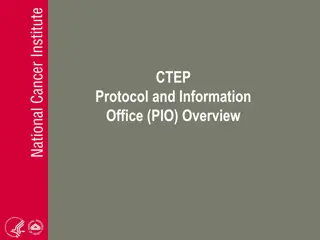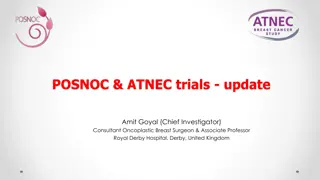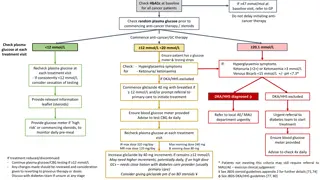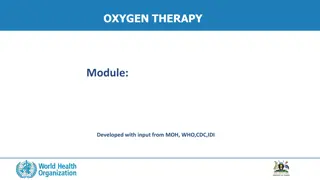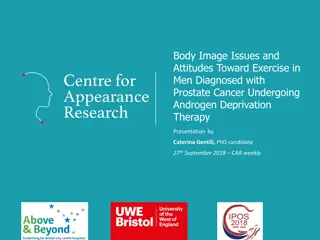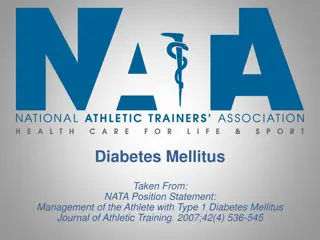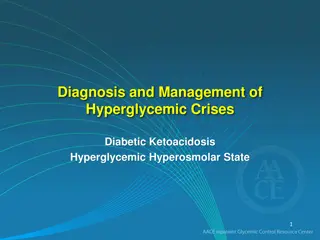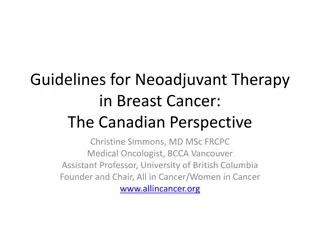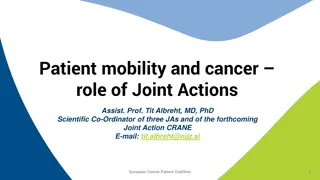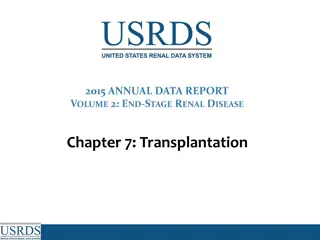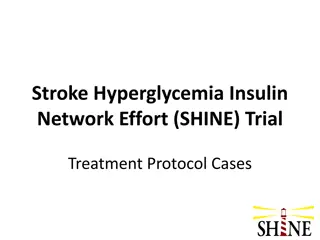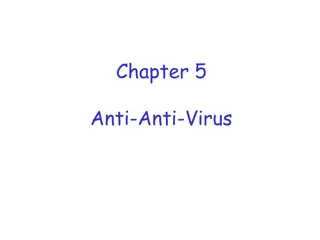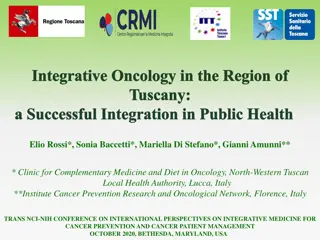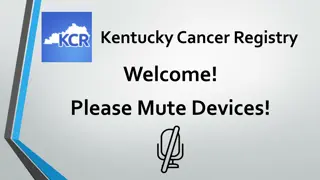Guidelines for Managing Hyperglycemia in Cancer Patients Receiving Anti-Cancer Therapy
Cancer patients undergoing anti-cancer therapy need vigilant monitoring for hyperglycemia. Baseline HbA1c and random plasma glucose levels must be checked before initiating therapy. Regular glucose monitoring, symptom assessment, and ketone testing are crucial throughout treatment. Prompt referrals, medication adjustments, and close coordination with diabetes teams are essential for managing hyperglycemia effectively in these patients. The guidelines emphasize the importance of early detection and intervention to prevent diabetic ketoacidosis (DKA) or hyperosmolar hyperglycemic state (HHS) complications.
Download Presentation

Please find below an Image/Link to download the presentation.
The content on the website is provided AS IS for your information and personal use only. It may not be sold, licensed, or shared on other websites without obtaining consent from the author. Download presentation by click this link. If you encounter any issues during the download, it is possible that the publisher has removed the file from their server.
E N D
Presentation Transcript
Check HbA1c at baseline for all cancer patients If >47 mmol/mol at baseline visit, refer to GP Do not delay initiating anti- cancer therapy Check random venous plasma glucose prior to commencing anti-cancer therapy / steroids Commence anti-cancer/GC therapy Check plasma glucose at each treatment visit 20.1 mmol/L <12 mmol/L 12 mmol/L <20 mmol/L Ensure patient has a glucometer & testing strips If: Hyperglycaemia symptoms Ketonuria (>2+) or Ketonaemia >3 mmol/L Venous Bicarb <15 mmol/L +/- pH <7.3* Check: - Hyperglycaemia symptoms for - Ketonuria/ ketonaemia Recheck plasma glucose at each treatment visit - If consistently <10 mmol/L consider cessation of testing if DKA/HHS excluded Commence gliclazide 40 mg with breakfast if 12 mmol/L and/or prompt referral to primary care to initiate treatment DKA/HHS diagnosed DKA/HHS excluded Provide relevant information leaflet (steroids) Urgent referral to diabetes team to start treatment Refer to local AE/ MAU department urgently Ensure glucometer provided Advise to check 4x daily Provide glucometer if high risk or commencing steroids, to monitor daily pre-meal Recheck plasma glucose at each treatment visit. Ensure glucometer provided Advise to check 4x daily If treatment reduced/discontinued: - Continue plasma glucose/CBG testing if 12 mmol/L - Any changes made should be reviewed and consideration given to reverting to previous therapy or doses - Discuss with diabetes team if unsure at any stage Increase gliclazide by 40 mg increments if remains 12 mmol/L May need higher increments, potentially daily, if on high dose GCs will need close liaison with diabetes care provider (usually primary care) Consider giving gliclazide pm if on BD steroids * Patients not meeting this criteria may still require referral to MAU/AE exercise clinical judgement See JBDS steroid guidelines appendix 2 for further details [64] See JBDS DKA/HHS guidelines [73, 76]
Check HbA1c at baseline for all cancer patients If >47 mmol/mol at baseline visit, refer to GP Do not delay initiating anti-cancer therapy Counsel patients to seek immediate medical attention if there are symptoms of hyperglycaemia as DKA can occur rapidly in these patients Check random venous plasma glucose prior to commencing ICP Commence ICP Check plasma glucose at each treatment visit <12 mmol/L 12 mmol/L <20 mmol/L 20.1 mmol/L Check: - Hyperglycaemia symptoms for - Ketonuria/ Ketonaemia Check: Hyperglycaemia symptoms Ketonuria (>2+) or Ketonaemia >3 mmol/L Venous Bicarb <15 mmol/L +/- pH <7.3* Recheck with each ICP treatment visit if DKA/HHS excluded if yes if no Refer to diabetes team early DKA/HHS diagnosed DKA/HHS excluded Recheck at each treatment visit Check anti-GAD +/- anti islet cell antibodies Refer to local AE/ MAU department urgently Advise patient re: symptoms of hyperglycaemia Urgent referral to diabetes team/ consider admission Ensure patient has CBG meter/ test strips Advise to check 4x daily To seek medical advice if 20 mmol/L at home Patient requires treatment with insulin therapy See JBDS DKA/HHS guidelines [73, 76] * Patients not meeting this criteria may still require referral to MAU/AE exercise clinical judgement ICP should be withheld with grade 3 hyperglycaemia. Consider restarting once regulated with insulin
If >60 mmol/mol at baseline visit refer to usual diabetes care provider (DCP) Check HbA1c at baseline for all cancer patients Check random venous plasma glucose prior to commencing anti-cancer therapy / steroids Ensure patient has a glucometer & testing strips Check plasma glucose at each treatment visit On 2 separate readings 12 mmol/L 20.1 mmol/L <12 mmol/L Rule out DKA/HHS* See section 4d PWD diet controlled or on other NON SULPHONYLUREA treatments eg: - Metformin - Gliptins eg Sitagliptin, Linagliptin - Flozins eg. Dapagliflozin, Canaglifozin - Pioglitazone - Non-insulin injectables (eg. Victoza, Byetta) PWD already on SULPHONYLUREA eg - Gliclazide Continue usual diabetic regime (IR max dose 320 mg/day) (MR max dose 120 mg/day) Urgently refer and contact diabetes team Patients has no symptoms of hypoglycaemia, day or night. Is patient on max dose? If no hypo symptoms, commence gliclazide 40 mg morning Aim CBG 6-15 mmol/L pre-evening meal Yes No Titrate morning dose up to max dose Contact usual diabetes care provider PWD = Person with diabetes IR = Immediate Release MR = Modified Release See JBDS steroid guidelines appendix 2 [64] *See JBDS DKA/HHS guidelines [73, 76] Refer to usual diabetes care provider If treatment reduced/discontinued any changes made should be reviewed and consideration given to reverting to previous therapy or doses (discuss with diabetes team if unsure at any stage) If CBG remains 12 contact usual DCP
If >60 mmol/mol at baseline visit, refer to usual diabetes care provider (DCP) Check HbA1c at baseline for all cancer patients Advise patients to monitor/record CBGs QDS Check random venous plasma glucose prior to commencing anti-cancer therapy / steroids Review patient recorded blood glucose at each visit On 2 separate readings Check for urinary ketones 12 mmol/L If on once daily insulin* e.g. Insulatard, Humulin I or Lantus If on twice daily insulin If on basal bolus insulin Contact diabetes team Contact diabetes team Contact diabetes team If unable to contact DM team: Morning dose will need to increase 10-20% according to pre-evening meal CBG If unable to contact DM team: Increase short/fast acting insulin by 10-20% until glycaemic target reached If unable to contact DM team: Titrate by 10-20% according to pre evening meal CBG If treatment reduced/discontinued any changes made should be reviewed and consideration given to reverting to previous therapy or doses (discuss with diabetes team if unsure at any stage) *If long acting insulin is taken once nightly, move this pre-bed injection to the morning and increase dose according to pm CBG See JBDS steroid guidelines appendix 2 for further management on titration [64]






